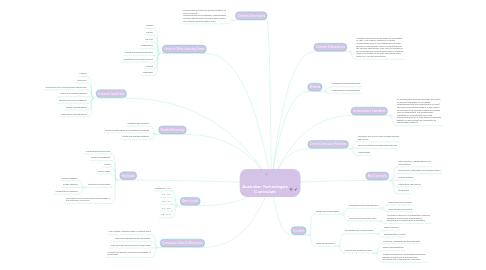Australian Technologies Curriculum
by Abby Ryan


1. Band Levels
1.1. Foundation - Yr 2
1.2. Yr 3 - Yr 4
1.3. Yr 5 - Yr 6
1.4. Yr 7 - Yr 8
1.5. Yr 9 - Yr 10
2. Curriculum Aims & Objectives
2.1. Use a variety of technologies in creative ways
2.2. Select and use appropriate technology
2.3. Make informed decisions about technology
2.4. Critique own designs using their knowledge of technology
3. Content Descriptors
3.1. Technologies includes content descriptions at each band level. These describe the knowledge, understanding and skills that teachers are expected to teach and students are expected to learn
4. Key Ideas
4.1. Creating preferred futures
4.2. Project Management
4.3. Safety
4.4. Animal Ethics
4.5. Thinking in technologies
4.5.1. Systems thinking
4.5.2. Design thinking
4.5.3. Computational thinking
4.6. Information and communication technologies in the Australian Curriculum
5. Student Diversity
5.1. Students with disability
5.2. Students with English as an additional language
5.3. Gifted and talented students
6. General Capablities
6.1. Literacy
6.2. Numeracy
6.3. Information and Communication Technology
6.4. Critical and Creative Thinking
6.5. Personal and Social Capability
6.6. Ethical Understanding
6.7. Intercultural Understanding
7. Links to Other Learning Areas
7.1. English
7.2. History
7.3. The Arts
7.4. Mathematics
7.5. Health and Physical Education
7.6. Humanities and Social Sciences
7.7. Science
7.8. Languages
8. Achievement Standards
8.1. An achievement standard describes the quality of learning (the depth of conceptual understanding and the sophistication of skills) that would indicate the student is well-placed to commence the learning required at the next level of achievement. The achievement standards for Technologies reflect the distinctive practices of each subject along with aspects of learning that are common to all Technologies subjects.
9. Key Concepts
9.1. Data collection, representation and interpretation
9.2. Specification, algorithms and implementation
9.3. Original systems
9.4. Interactions and impacts
9.5. Abstraction
10. Content
10.1. Design and Technologies
10.1.1. Knowledge and Understanding
10.1.1.1. Technology and societies
10.1.1.2. Technologies and context
10.1.2. Process and Production Skills
10.1.2.1. Creating solutions by; investigating & defining, designing, producing & implementing, evaluating and collaborating & managing
10.2. Digital Technologies
10.2.1. Knowledge and Understanding
10.2.1.1. Digital Systems
10.2.1.2. Representation of data
10.2.2. Process and Production Skills
10.2.2.1. Collecting, managing and analysing data
10.2.2.2. Digital implementation
10.2.2.3. Creating solutions by; investigating & defining, designing, producing & implementing, evaluating and collaborating & managing
